 |
|
 |
|

Information and Interaction in MarketSpace
and their Implementation in Prolog
(Position Paper)
Joakim Eriksson¹,
Niclas Finne¹, and
Sverker Janson²
¹Telia Research AB, S-123 86 Farsta, Sweden
E-mail: {joakime,nfi}@sics.se
²Swedish Institute of Computer Science
SICS, Box 1263, S-164 28 Kista, Sweden
E-mail: sverker@sics.se
1. Introduction
1.1. Market Infrastructures
Current web-based commerce is by and large a replica of real-world
commerce. Customers are supposed to visit various electronic
storefronts, inspect the digital displays of goods and services, and,
perhaps after some comparison shopping, place an order.
Unfortunately they have to do it in person. Attempts at supporting
the customer through ``intelligent agents'' are guaranteed to be in
vain, unless the underlying model is changed. It would have to be one
bright agent to, using the web as is, find a few good deals on a
fridge at nearby resellers, haggle prices and delivery conditions, and
then present the three best alternatives. Which minute fraction of
the 50000 hits on ``refrigerator'' in AltaVista is at all relevant?
In these, what part of the text is the price, the model, the delivery
conditions?
Needless to say, much better models are possible, in which the above
would be a very basic service, and one such model will sooner or later
supplant the web-based models. The web, and associated technologies
such as Java, will remain as the user interface, but a new
infrastructure will emerge that is targeted to the task of creating a
near-perfect global market.
In this position paper, we present work towards such an
infrastructure, characterised by openness and by being based on
a paradigm of interacting agents.
We would like the market to be open like the web. Nobody should own
it. Anyone should be able to enter it. Anyone should be able to
offer any kind of service, such as brokering. This is typically not
the case with current markets, where all information is owned by the
market operator and not available for use by others
[1,
2].
A market has to support more activities than just finding the desired
product or customer. Well-defined interaction protocols are needed
for negotiation. Ideally, these protocols should make sense for
human-human, human-agent and agent-agent interaction alike, to make
possible any mix of human and automated participants in the market.
(For an agent-only market, see, e.g., Kasbah
[3].)
Note that although the issues of security and payment are strongly
emphasized in most works on electronic commerce, they are quite
orthogonal here. Any future standards will do.
1.2. MarketSpace and Logic Programming
Our MarketSpace model is at the implementation level similar to other
Internet-based infrastructures. Prolog is as always an efficient
prototyping tool, but the application area at hand places entirely new
requirements on languages and systems, such as a need for
multithreading and persistence. Constraints would seem particularly
useful for some purposes, but again new requirements affect their use.
We will offer our preliminary thoughts on these issues in the
conclusions.
1.3. Organisation of this Document
In the remaining sections, we outline the information and interaction
models that support our preliminary MarketSpace infrastructure,
describe the design of a MarketSpace server prototype and its
implementation in SICStus Prolog and Prolog Objects
[4], and finally offer a
few concluding remarks.
2. Information and Interaction
2.1. Information
Interests are the essential pieces of information in a market. They
describe what a participant (person, company, organisation, etc) is
concerned about, curious about, intends to do or wants. There are
several different kind of interests from simple forms of interests
like ``I am interested in cats'' to more complicated like ``I want
to buy all things needed to build a spacecraft and hire personnel to
build it''. Since the goal of a market participant is to make
deals, an interest can be said to describe a set of potential deals.
We will now try to make these concepts a little more precise.
What we will need to know about a deal is that it has a type,
some participants involved, and a time when it is entered. As basic
types we have (the names of) participants in the market, which
are either human or programmed, and time points. The deal
type includes everything else, such as what is sold, delivery
conditions, etc. With each deal type is associated a set of
rôles, which are the parts played by participants in a deal, such
as buyer or seller. A deal assigns participants to all the rôles in
its type.
An interest is a set of deals. An expression of interest
(eoi) is a representation of an interest.

Figure 1: Example of a Possible EOI
It is clearly desirable that expressions of interest are both
expressive and computationally tractable, and using constraints
springs to mind, but we have not yet explored this possibility.
2.2. The Interaction Model
Based on the interests, we define a very simple speech-act style
interaction protocol. It consists of information messages:
ask and tell, and negotiation messages: propose, reply,
accept, and reject.
ask(A, B, eoi, id)
A asks B for information on interests, giving an eoi (possibly
but not necessarily its own interests) as guidance. Replies can
be given by tell.
tell(A, B, eoi), tell(A, B, eoi, id)
A tells B about some interests (possibly its own). If this is
intended as an answer, the question can be referred to by its id.
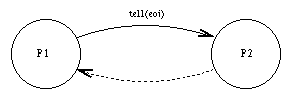
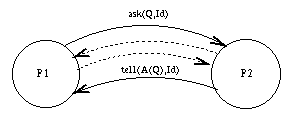
Figure 2: Tell and Ask
propose(A, B, eoi, id)
A initiates negotiation with B, giving an interest as guidance.
Replies are given by reply, accept, or reject.
reply(A, B, id, eoi, id)
A replies to B's latest bid. The interest given need not
have any special relation to the bid. (It is up to the participants
involved to assess the progress of the negotiation and interrupt it
when necessary.)
accept(A, B, id, id)
A accepts B's latest bid. This is equivalent to signing a
contract. The reply is to accept or reject.
reject(A, B, id)
A aborts the current negotiation with B.
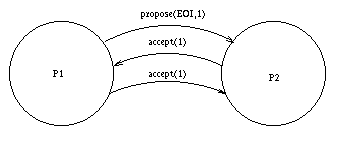

Figure 3: Negotiation
This simple protocol can be regarded as a subset of a richer more
KQML-like protocol, other elements of which will be needed
[5]. We are currently
exploring conversational styles and idioms using these basic messages,
rather than integrating capabilities through complex message types.
This will allow some, simpler, participants to have a more naive view
of interaction, while more advanced participants can recognize and
enjoy the benefits of more elaborate patterns of interaction.
3. A MarketSpace Server
We have developed a MarketSpace server architecture and prototype
implementation based on the ideas presented above. The prototype
was developed using SICStus Prolog (version 3) and Prolog
Objects.
The rôle of this server in the MarketSpace infrastructure is
both to support human participants, with whom it will interact by
emulating a web server, and programmed participants (agents), for
which it will serve as a scheduler and communication mediator.
Since this paper is intended for a readership interested in logic
programming and its use for Internet applications, various aspects of
the implementation will be described in more detail than otherwise
called for. The purpose is to emphasize advantages of the
object-oriented programming model, as well as the roundabout coding
style needed in a single-threaded system.
3.1. The Marketserver Architecture
The MarketSpace server architecture has three main components (see
Figure 4):
-
the kernel, which handles the events that schedule activities in
the system and communication with the outside world;
- the protocol handlers, which register the protocols they
listen to and get the corresponding events from the event handler
when data arrives;
- the agent environment, which implements the runtime
enviroment for agents.
Two event types are built-in: The time events are used by
system components (objects) that wish to be scheduled at regular
time intervals and the stream events signal the arrival of
data from the outside world to system components such as the
protocol handlers.

Figure 4: The Basic MarketSpace Architecture
3.2. The Object Model
The implementation relies heavily on the Prolog Objects extension
of SICStus Prolog. The basic objects (prototypes) are
root, which adds initialisation and finalisation capabilities,
and persistent, which also adds the ability to save
(checkpoint) and recreate state from secondary storage. The
persistence mechanism is also used for migration of objects.
Since objects and object implementations should be mobile there
is a mechanism to load required object implementation files.
When new object implementations are added to the system, it loads
the implementation file and detects new object types. New object
types are registered in a database enabling the implementation
file to be restored when the object types are needed.
3.3. The Kernel
The kernel is the main engine of the system and has two important
rôles: one is to generate stream and time events, the other is to
distribute events among subscribing objects. The kernel consists of
the following objects:
-
the stream handler object handles the communication from the outside
world with the system using socket and stream communication;
- the time handler object handles generation of time
and delay events;
-
the event handler, which is the main kernel object, and handles
scheduling of events to the system objects.
The functionality of the kernel can be seen as two systems, one is the
event system and the other is the stream and protocol system.
The event system generates stream and time events using the time
handler, time agent and stream handler objects. If there is a need
for more event types, the register event and add event
methods can be used. An example of this is how time events are
generated.
-
At initialisation, the timeagent registers the time event, adds a
time event and subscribes to time events.
-
Each time the timeagent receives a time event, it makes a request
for the next time event at the time handler.
Objects that subscribe to events should implement the method
event, by which they are delivered to the object by the event system.
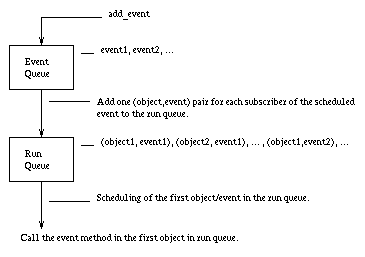
Figure 5: The Event Loop - Event Scheduling in the
Event Handler
As seen in Figure 5 there
are two queues in the event system. One queue is for queueing incoming
events and the other acts like a run queue. Each time the event loop
is executed, the first event in the event queue is dequeued and all
subscribers to that event is placed in the run queue. After the event
has been dequeued, the event loop will schedule the first subscriber
in the run queue.
eventhandler::{
[ ... ]
add_event(Event):-
event_db(Event,_Y),
get(events(Q)),
queues:queue_last(Event,Q,NewQ),
set(events(NewQ)) &
register_event(Agent,Event):-
\+ event_db(Event,_Y),
assert(event_db(Event,[Agent])) &
[ ... ]
subscribe_event(Agent,Event):-
subscription_db(Event,List),
lists:non_member(Agent,List),
update(subscription_db(Event,[Agent|List])) &
[ ... ]
scheduler:-
schedule_event,
schedule_agent,
streamhandler::select(Reads),
handle_reads(Reads),
timehandler::get_next_event,
scheduler
}.
The Prolog code above is part of the event handler. The
scheduler method is the event loop which keeps the system running,
using the stream handler and the time handler to generate events.
The stream and protocol system generates the stream events and
takes care of stream communication with the outside world. The main
component of this system is the stream handler which sets up a port
using the socket library through which it receives all incoming data.
When a new stream is opened through the port, the event handler will
read data from the stream until it can determine which protocol is
used. Then, a stream event is generated marked with a protocol tag
(e.g. http(Stream)).
The protocol database is empty at initialisation time. For each
protocol, its id and header have to be registered.
streamhandler::{
[ ... ]
init(Port):-
sockets:current_host(Host),
sockets:socket('AF_INET', Socket),
user:on_exception(system_error(X),
sockets:socket_bind(Socket, 'AF_INET'(Host,Port)),
(utils:lformat(5,'*** Error binding socket: ~w~n',[X]),
user:fail)),
sockets:socket_listen(Socket,5),[ ... ] &
[ ... ]
select(ReadStreams):-
get(socket(Socket)),
get(streams(Streams)),
sockets:socket_select(Socket,New,Client,0:200,Streams,ReadStreams),
[ ... Handle new stream ... ] &
}.
The above Prolog code is part of the stream handler, which
handles all socket communication. The init method shows the
initialisation of the communication socket and the select method
shows the listening for new data. The socket_select predicate
both check if there is a new stream opened and if there is new data on
the old streams.
3.4. The Protocol Handlers
The protocol handlers handle data arriving from the outside world.
They register the protocols and subscribe to stream events from the
event handler. The following Prolog code from the term handler object
illustrates the interaction between the protocol handler and the
event handler.
termhandler::{
super(root) &
[ ... ]
init:-
self(Self),
protocols:term_header(Term),
eventhandler::register_protocol(term,Term),
eventhandler::subscribe_event(Self,term(_))&
finish :-
self(Self),
eventhandler::unsubscribe_event(Self,term(_)) &
event(term(Stream)):-
protocols:read_term_message(Stream,Term),
[ ... Execute the Prolog term and get a result ... ]
protocols:send_term_message(Stream,Result),
eventhandler::end_stream(Stream)
}.
The init method takes care of the registration of the protocol
and the subscription to stream events, the finish method the
unsubscription, and the event method the reception of stream
events.
The HTTP handler handles World Wide Web communication and
forwards parsed HTTP messages to other objects. (A DCG parser could
easily be derived from the HTTP specification
[6].)
Objects can subscribe to a specific path whereby web accesses matching
that path will be forwarded to the subscriber. The following system
objects subscribe to HTTP events:
-
htmlserver - Subscribes to the empty path and receives all web
requests not catched by other subscribers. Replies with files matching
the web request.
-
cgibinserver - Subscribes to the path
"cgi-bin" and handles user registration and
authentication.
-
cgiobject - Subscribes to the path
"cgi-object" and provides a way to inspect
Prolog Objects from the web.
The DOP handler handles communication with the DOP, Distributed
Object Protocol, which is a simple protocol (defined by us) for
distributing objects. When an object is sent to another server, the
state and a list of required object types are extracted from the
object and sent in a DOP message. When a message arrives the DOP
handler parses it and creates an object of the specified object type.
If that object type or any other required object type is unknown, the
creation is suspended until the missing type becomes known. After the
object has been created, it must self take care of whatever it is
supposed to do. For example, deliver itself to an agent.
The TERM handler handles communication with the TERM protocol.
TERM messages are parsed into Prolog terms and executed within the
server context. The result is returned to the caller. This makes it
possible to examine and control a running server which is very useful
for debugging.
3.5. The Agent Environment
At the top level of the architecture we have built a simple agent
environment in which programmed participants in the marketspace can
reside. The agent environment implements a small set of features
useful for agents. These are
-
Registration of requirements and description
-
Agent communication
-
Retrieval of information about other agents
The agent environment can be divided into two components. One is the
agentenv object which implements a set of features for agent
communication and registration. The other is the administrator agent,
which handles simple questions about the local (and in the future also
the distributed) agent environment.
collectoragent::{
super(persistent) &
[ ... ]
init(state(none)) :-
self(Self), agentenv::register_agent(Self,[],[time]) &
finish :-
self(Self), agentenv::deregister_agent(Self) &
time:- [ ... ]
incoming_message(Msg,From) :-
Msg::class(MsgType),
incoming_msg(MsgType,Msg,From) &
incoming_msg(interact_aipv1,Msg,From) :-
[ ... Handle the interaction message ... ]
}.
The above Prolog code is part of a simple agent and illustrates how an
agent interacts with the agent environment. The first method,
init, shows the initialisation of the agent when it is recreated and
finish the clean up before the agent is abolished. The
time method is called at regular intervals since the time event was
subscribed to in init. The incoming message method
exemplifies how the agent handles reception of messages.
3.6. Interests and Interactions
For the present, the interests of the general model have
a fairly simple representation:
-
Items, like products to sell, are represented as objects with a set of
methods for accessing information about concepts and instance values.
-
Deals are represented as different objects according to deal type.
-
EOIs, Expressions Of Interest, are represented as objects with a
list of deal objects. Methods for accessing EOI information (like
deals) exists as well as set operations like union,
intersect and partition
The interaction model is implemented using interaction (or message)
objects. They inherit from the persistent object (enabling migration)
and have methods for accessing message information and sending the
message to another agent.
To send an interaction object to another agent, the sender call the
corresponding method.
ia::{
super(simpleagent)&
[ ... ]
rcv_ask(Eoi,Id):-
get(general_eoi(MyEoi)),
Eoi::intersect(MyEoi),
tell(Eoi,Id)&
rcv_reply(Eoi,_Ref,Id):-
get(status(proposed)),!,
update_latest_eoi(Eoi),
get(precise_eoi(MyEoi)),
(
Eoi::intersect(MyEoi) ->
set(status(dealing)),
update_latest_eoi(Eoi),
reply(Eoi,Id,_NewRef)
;
reject(Id),
set(status(none)
)&
[ ... ]
}.
This Prolog code is part of the agent, ia, which performs simple
price negotiation. The methods rcv_ask and rcv_reply are
called when the agent receives ask and reply messages. The ask method
intersects the incoming EOI object with its own interest, MyEoi,
to find out if they have something in common. If so, the resulting
EOI will be sent back as a reply using the tell method.
3.7. Example
Finally, we illustrate the use of this architecture and system by an
interaction between two servers: the blue server and the
red server.
The blue server provides a web interface to interact with human
participants, who can create, change and remove interests from their
interest store, and engage in negotiations, all through dynamic web
pages (generated using the package by Cabeza and Hermenegildo). The
blue server hosts a collector agent, which looks for new interests and
forwards them to a broker agent at the red server with the purpose of
matching interests.
The red server lets human participants specify their interests as
URLs to web pages in which the interest is given in a special
syntax. The red server fetches the specified web page and parses
the interest. The red server also hosts a broker agent to which
a human participant can delegate the task of negotiating a deal,
giving upper and lower price limits.
In addition, a log server subscribes to log events from the
other servers, and displays what is going on in the marketspace.
3.8. Example Scenario
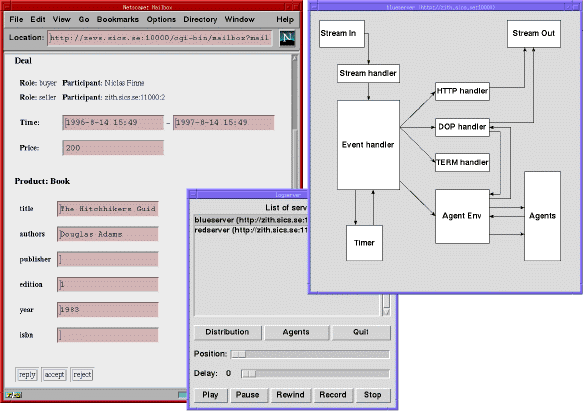
Figure 6: Snapshot of a Proposal given to a User
(left window) and the Log Handler
The following simple scenario illustrates a possible interaction in
the marketspace.
-
User A on the blue server specifies that she wants to buy a
book. The user does this by creating an interest and specify the
rôle to act (buyer, seller) and the product to buy or sell.
This interest is stored in a user store which is accessible by
all agents in the marketspace.
-
User B on the red server specifies that she wants to sell a book
by specifying a URL to a web page (in the special format). The web
page is fetched and information about the interest is extracted and
put in the user store.
-
User B on the red server delegates her interest to a broker
agent through an agent interface to which the broker agent has
registered. When delegating the interest, the user specifies an
acceptable price and a suitable starting price. During
negotiation, the broker agent starts with the starting price and
slowly goes to the acceptable price trying to get the best price.
-
A collector agent in the blue server collects all local interests and
sends them to the broker agent. At the moment this is done at regular
intervals, but in the future it will probably be some form of
subscription. To collect all local interests, the collector agent
starts by asking the administration agent for all local agents (which
also includes users). Then the agent asks each such agent for their
interests and when the agent happends to be a user, the user handler
catches the message and answers it by fetching the users interests
from the user store. The union of all interests found are sent to the
broker agent at the red server.
-
The broker agent receives the interest and checks for a matching
interest by taking the intersection between the received interest and
the delegated interest. If the intersection not is empty, the broker
agent changes some information as for example price and sends a
proposal to the agent that owns the interest. In this example it is
user A at the blue server but it could just as well been a
programmed participant.
-
User A receives a message from the broker (see Figure
6) and the message is converted into a web page when
the user reads it. The web page describes who the sender is, the type
of message and its contents together with buttons to do various
actions with it. For example, the user can choose between
accept, reject and reply when replying to a proposal.
The user chooses to negotiate by changing the price and selecting
reply. A reply message is created and sent to the broker agent.
-
The user and the broker agent negotiates until both accepts a
deal (or someone rejects in which case the broker agent tries to find
another agent to negotiate with).
-
When the broker agent finally settles a deal, the user B
is informed.
4. Conclusions
In summary, focusing on the logic programming aspects of our
work,
-
Prolog (and Prolog Objects) is, as usual, an efficient
prototyping and implementation tool, and also for Internet
applications;
-
constraints might offer the expressiveness needed for representing
and manipulating interests in MarketSpace;
-
the need for a multithreaded Prolog becomes painfully apparent;
-
although it is easy enough, Prolog is not suitable for migrating
code in an open system due to security problems.
There are nice solutions to many of the security problems in
various languages and implementations, but to be successful a
market infrastructure cannot depend on the quirks of minor
programming languages.
The same holds for the use of constraints. If they are to be
used, this is either invisibly, or in a way that is easy to
reconstruct by independent developers of software components for
the market infrastructure.
Multithreading is a more neutral issue. In this, and other,
Internet-applications, (pre-emptively scheduled) light-weight
threads are clearly useful. The work-around with tasks scheduled
``by hand'' employed here is very painful. We expect that most
Prolog implementations will offer multithreading in the very near
future.
Finally, for those who are interested in exploring systems of this
kind using Prolog, we offer our prototype as a starting point (see
http://www.sics.se/isl/commerce).
References
- 1
-
Internet Shopping Network.
URL:
http://www.internet.net.
- 2
-
Polycon AB.
The Webra Marketplace.
URL:
http://www.polycon.fi/webra.
- 3
-
Anthony Chavez and Pattie Maes.
Kasbah: An Agent Marketplace for Buying and Selling Goods.
In Proceedings of PAAM'96, 1996.
Also available as
http://lcs.www.media.mit.edu/groups/agents/Publications/kasbah-paam96.ps.
- 4
-
Swedish Institute of Computer Science.
SICStus Prolog User's Manual, 1995.
Also available via
http://www.sics.se/isl/sicstus.html.
- 5
-
Tim Finin and Richard Fritzson.
KQML as an Agent Communication Language.
In Proceedings of the Third International Conference on
Information and Knowledge Management, 1994.
Also available via
http://www.cs.umbc.edu/kqml/papers/kqml-acl.ps.
- 6
-
T. Berners-Lee, R. Fielding, and H. Frystyk.
Hypertext Transfer Protocol - HTTP/1.0.
available at
http://www.w3.org/pub/WWW/Protocols/HTTP1.0/draft-ietf-http-spec.html.
 |
|
 |
|








